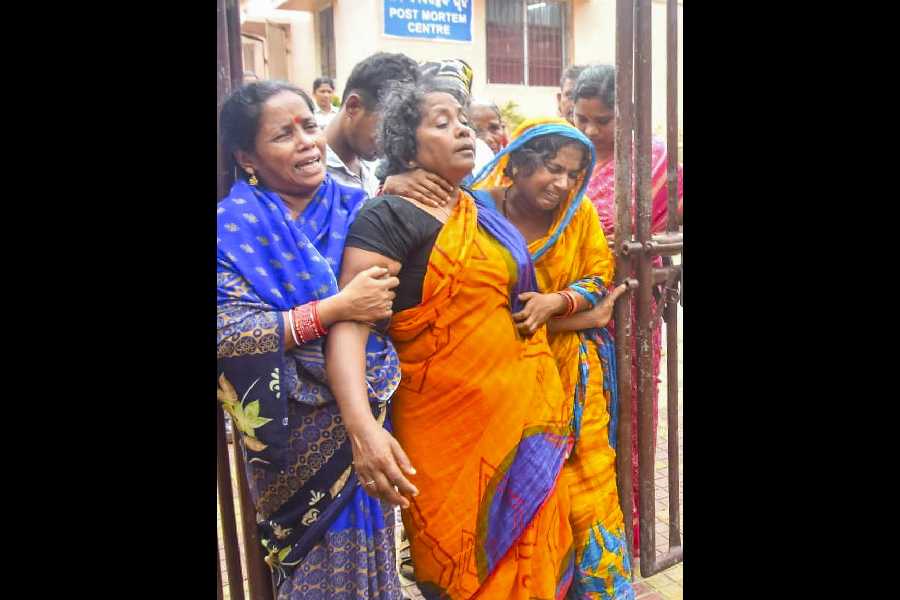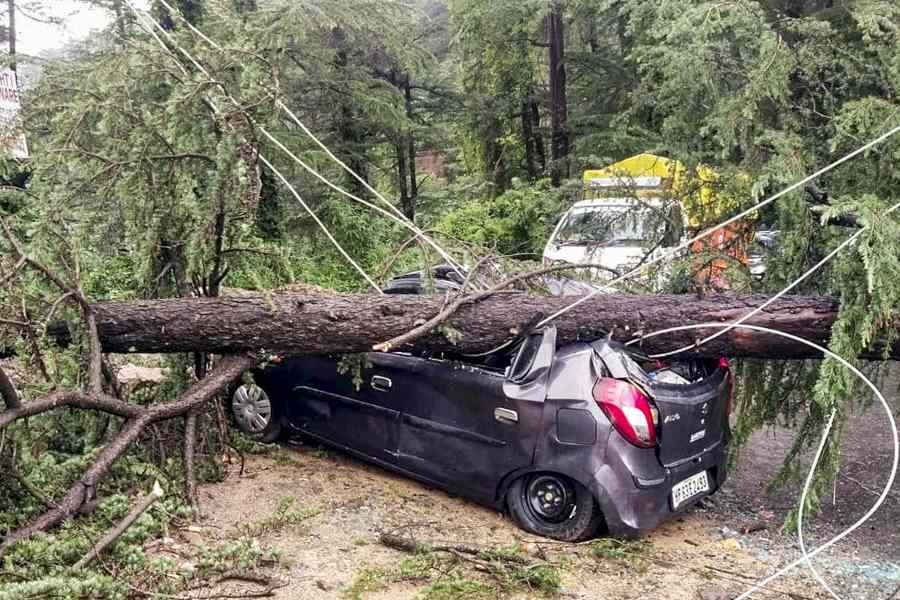 |
| A bird’s eye view of a day in the life of passengers at the city airport with multiple queues merging and (below) Mumbai cuts a contrasting picture |
 |
■ Metro rail counter: Queue up once, 8-10 minutes on an average
■ Store counter: Queue up once, 10-12 minutes on an average
■ Railway counter: Queue up once, 10-20 minutes on an average
■ Power/phone bill payment counter: Queue up once, 15-20 minutes on an average
■ Calcutta airport: Queue up four times (not counting once inside the toilet), one-and-a-half hours
Come to Calcutta airport with a cushion of two hours and queue up quietly or quarrel with co-passengers while trying to dodge the line in desperation — the choice is yours.
Sanjay Lamba, a senior executive with a multinational company, took the first option last week and still barely managed to board his flight on time.
“I reached the airport two-and-a-half hours before the scheduled departure of my IndiGo flight to Delhi, only to spend most of it standing in queues and looking at my watch. Those were the longest airport queues I have seen,” Lamba told Metro.
“It’s such a shame to see fliers being forced to push and shove one another to board a flight,” he added.
So chaotic is the everyday rush-hour scene in front of each counter — from baggage scan to boarding — that even airlines operating flights to and from the city have become queue-phobic. On an average, four to five flights are being delayed by 15 minutes during peak hours every day because passengers who have already checked in are waiting for security check.
As the clock ticks away and the pressure to maintain schedules piles up, worried airline staff move around with walkie-talkies seeking out passengers stuck in the queues. And when they try to help those passengers beat the queue, others protest.
“Fliers as well as airline ground staff face trouble for no fault of theirs while those responsible for the mess remain unaffected. How long can this go on?” protested the operations manager of a low-cost carrier that runs over 15 daily flights to and from the city.
Two weeks ago, senior executives of a private airline made a trip to the city to find out and file a report on the flight delays responsible for throwing the entire schedule haywire. “They had a first-hand experience of the snail-slow speed at which queues move at the city airport. Thank god, they now know that it is not our fault,” said a member of the airline’s ground staff.
Airport officials cite a different reason for the queue at each step, though the common thread is mismanagement. Not a single terminal traffic survey has been conducted over the past few years to even check whether infrastructure and manpower match the growth in numbers.
“The last time such a survey was conducted in 2006. The number of passengers has since shot up from six million to 10 million a year but the manpower strength of the Central Industrial Security Force (CISF) is more or less the same. How can they be expected to handle an additional four million fliers without more personnel?” protested an airport official.
“There is no point in doing a new survey now as the existing domestic terminal will be discarded soon. A survey will be conducted once the integrated terminal comes up,” insisted airport director R. Srinivasan.
Of the four bottlenecks inside the terminal, the X-ray counter for registered baggage is the one for which there is a ready solution that hasn’t been implemented for an inexplicable reason.
“The in-line baggage system has been installed but we haven’t been able to use it because the Bureau of Civil Aviation Security is yet to clear it,” airport director Srinivasan said.
All major airports, including Mumbai, Delhi, Bangalore and Hyderabad, have long done away with the obsolete system of scanning luggage at a separate X-ray counter. Calcutta is the only metro that hasn’t introduced inline baggage screening, forcing passengers to wait at least 10 minutes to get their bags scanned by one of the four X-ray machines.
In the check-in arena, the problem is the shortage of counters — 50 to Mumbai’s 118 — and space. “Trolleys scattered near the counter eat up the available space but nobody seems bothered,” said surgical oncologist Gautam Mukhopadhyay, a frequent flier.
Snags in the new luggage conveyor belt where the in-line scanning software has been installed have been further slowing down the check-in process, according to airline staff.
So if you happen to be checking in during the morning or evening rush hour, add at least another 10 minutes to your waiting time before you get your boarding pass.
The third — and apparently the most irritating — bottleneck is security check. The serpentine queues often merge with those for check-in, leaving hardly any room for passengers to stand comfortably. “Passengers in the line often panic when they hear boarding announcements and try to break the queue. Quarrels break out and that adds to the problem,” said a CISF official.
Officials of the Airports Authority of India are, of course, nowhere to be seen during the chaos. On an average, a passenger needs to wait up to 45 minutes during peak hours to clear security check.
The agony doesn’t end with security check. “Outside the boarding gate, there is congestion at all times with at least three airlines lined up for departure back-to-back. “There have been instances of passengers boarding the wrong coach and reaching the wrong aircraft,” said an official.
The airport has three boarding gates on the ground floor and four on the first that aren’t used. “There are also three aerobridges, one of which is out of order most of the time,” said an official.
The airport authorities blame the alleged refusal of airlines to use the first-floor boarding gates for the congestion.
From the airport gate to the aircraft door, it’s a blame game all the way with one loser: the flier.











